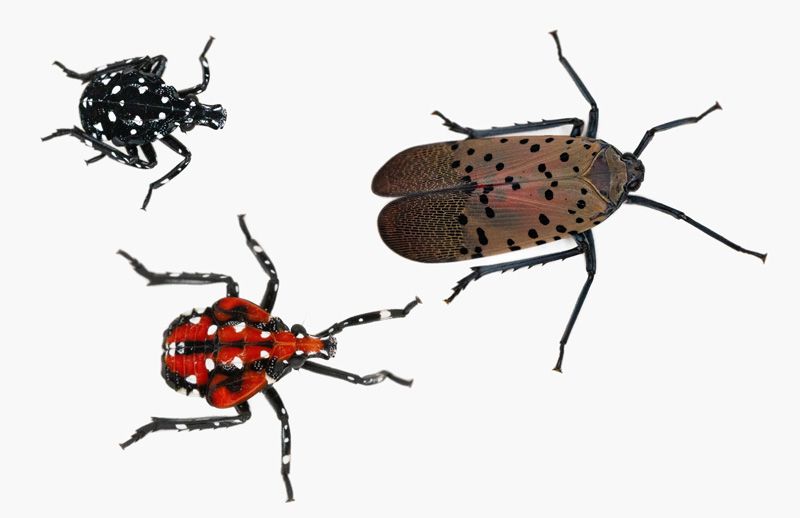
Spotted Lanternfly – Lycoma delicatula
Spotted Lanternfly – Lycoma delicatula
Description of Insect:
The Spotted Lanternfly (Lycorma delicatula) is an invasive planthopper native to China and Vietnam. Adults are strikingly colorful, with gray forewings adorned with black spots and vibrant crimson hindwings hidden beneath. They measure about 25 mm in length and have a distinctive, moth-like appearance when at rest. Their abdomen is yellowish in color and features black and white stripes on top and bottom.
Their nymphs are equally recognizable, beginning as black-bodied insects with white spots before transitioning into bright red with black and white markings. Unlike many other invasive pests, the Spotted Lanternfly does not bite or sting, nor does it directly bore into trees. Instead, it feeds on plant sap using its specialized piercing-sucking mouthparts.
This feeding weakens plants, leading to defoliation, wilting, dieback, and in some cases, plant death. The pest is particularly attracted to the Tree of Heaven (Ailanthus altissima), but it also infests grapevines, fruit trees, and hardwood species. Since its first detection in the U.S., the Spotted Lanternfly has spread rapidly, prompting concerns about its environmental and economic impact.
Life cycle of Spotted Lanternfly:
The Spotted Lanternfly undergoes incomplete metamorphosis, consisting of three stages: egg, nymph, and adult. The cycle begins in early fall when females lay egg masses on smooth surfaces such as tree trunks, outdoor furniture, and rocks. Each egg mass, covered with a protective, mud-like coating, contains 30-60 eggs.
In spring, nymphs hatch and begin feeding on a wide range of plants. The first three nymphal instars are black with white spots, while the fourth instar develops striking red coloration. Nymphs are highly mobile and climb trees, feeding on sap by piercing plant tissues.
By mid to late summer, nymphs molt into adults, which continue feeding and laying eggs for the next generation. Adults are strong jumpers but weak flyers, often hitchhiking on vehicles, firewood, or outdoor materials to spread to new areas. The insect completes one generation per year, with eggs overwintering and hatching in the spring.
Damage they cause:
The Spotted Lanternfly poses a severe threat to agriculture, forestry, and ornamental plants. Its feeding behavior weakens host plants, while the sugary excretions it produces encourage the growth of harmful mold.
- Crop and Vineyard Damage:The Spotted Lanternfly is especially harmful to grapevines, feeding on vines and reducing fruit yield. Wineries and vineyards face substantial financial losses due to decreased grape quality and increased pest management costs. Additionally, the pest targets plants such as black walnut, cucumber, and rose, as well as hardwood trees like maples. Repeated feeding weakens trees, stunting their growth and making them vulnerable to diseases and other pests.
- Honeydew and Sooty Mold Growth:As Spotted Lanternflies feed, they excrete a sticky, sugary substance called honeydew. This substance coats leaves, branches, and nearby surfaces, promoting the growth of sooty mold. The mold blackens plants, reducing photosynthesis and further weakening affected vegetation.
- Urban and Residential Impact:The pest is a major nuisance in urban and suburban areas. Swarms of Spotted Lanternflies can make outdoor spaces unusable, affecting parks, gardens, and recreational areas. It impacts several outdoor activities, such as apple picking and wine tasting at local vineyards. The honeydew attracts wasps and other insects, causing frustration among the public.
